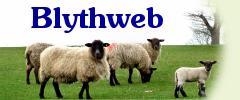Writing About Blythburgh History: A Select Bibliography
Few people would question the need for scientists or engineers, engaged upon new projects, to keep abreast of the development of knowledge and thinking within their subjects. It is less generally understood that an equivalent requirement applies to historical writing. Too often discredited interpretations are repeated and perpetuated uncritically.
‘Facts’ and ‘Truth’ are not very helpful words. Written history is an interpretation of evidence and therefore uncertain. Interpretation should be rigorous but it will always be open to review as more information becomes available. Evidence must be looked at carefully - ‘Artists’ impressions’ are often just that, reality may have been adjusted for effect. People often wrote with a particular audience in mind, and to represent themselves in a good light. And we all know how fallible are newspaper reports.
There is nevertheless some good reading available on Blythburgh history. Together with the study of Directories (1793 onwards) these suggestions will help to separate history from mystery!
- Timothy Beardsworth, ‘The flint-work inscription under the east window of Blythburgh church’ Proceedings of the Suffolk Institute of Archaeology and History, XXXVIII (1993)
- M. Janet Becker, Blythburgh, (Halesworth, 1935)
- Martin Carver, The Age of Sutton Hoo, (Woodbridge, 1992)
- H. Munro Cautley, Suffolk Churches, (5th ed. Woodbridge, 1982)
- J. B. Clare, Wenhaston and Bulcamp, Suffolk, (Halesworth, 1903)
- David Dymond and Edward Martin (eds), An Historical Atlas of Suffolk, (Ipswich, 1988)
- David Dymond and Peter Northeast, A History of Suffolk, (2nd ed. Chichester, 1995)
- David Dymond and Roger Virgoe, ‘The Reduced Population and Wealth of early Fifteenth–Century Suffolk’ , Proceedings of the Suffolk Institute of Archaeology and History, XXXVI (1986)
- Thomas Gardner, An Historical Account of Dunwich, Blithburgh and Southwold, (London, 1754)
- G. L. Gomme (ed.), Topographical History of Staffordshire and Suffolk, (London, 1899)
- C. Harper-Bill (ed.), Blythburgh Priory Cartulary, (2 vols, Woodbridge, 1980 and 1981)
- Birkin Haward, Suffolk Medieval Church Arcades, (Ipswich, 1993)
- Lord Francis Hervey (ed.), Suffolk in the Seventeenth Century, (London, 1902)
- John Kirby, The Suffolk Traveller, (2nd ed. London, 1764)
- Rachel Lawrence, Southwold River, (Exeter, 1990; new edn. Southwold, 1997).
- D. MacCulloch, Suffolk and the Tudors (Oxford, 1986)
- Judith Middleton-Stewart, Inward Purity and Outward Splendour: Death and Remembrance in the Deanery of Dunwich, Suffolk, 1370-1547,(Woodbridge, 2001)
- J. W. Newby, The Patrick Stead Hospital ... with notes on the Blythburgh and District Hospital, (Halesworth, 1964)
- Colin Richmond, John Hopton. A Fifteenth-Century Suffolk Gentleman, (Cambridge, 1981)
- Norman Scarfe, Suffolk in the Middle Ages, (Woodbridge, 1986); The Suffolk Landscape, (London, 1972)
- John Shaw, ‘The Finance and Construction of the East Anglian Houses of Industry’, Proceedings of the Suffolk Institute of Archaeology and History, XXXVII (1992)
- The Rev. Alfred Suckling, The History and Antiquities of the Hundreds of Blything and part of Lothingland, (London, 1847)
- Peter Warner, Greens, Commons and Clayland Colonization. The Origins and Development of Green–side Settlement in East Suffolk, (Leicester, 1987), and The Origins of Suffolk,(Manchester, 1996); Bloody Marsh: A Seventeenth–Century Village in Crisis, (Macclesfield, 2000)
- Arthur Young, General View of the Agriculture of the County of Suffolk, (London, 1813, facsimile 1969)
- A Survey of Suffolk Parish History, (Ipswich, 1990)
Alan Mackley, Blythburgh, rev. July 2001
Back to the History Index
Some Favourite Websites For April 2024:
Hare Lodge Self Catering – Two expansive but affordable pet friendly Self Catering
Two New England-style barn conversions at Hare Lodge in Peasenhall. Tastefully decorated with relaxation in mind and a comfortable sitting room, country kitchen and downstairs shower room.
Logs Logs Logs – Family Firm delivering kiln dried logs to Norfolk and Suffolk, including Norwich, Diss and Woodbridge
Logs available in tipper loads and bulk bags for wood burning stoves, open fires and pizza ovens. In addition supplying firewood in bulk bags to Essex, Cambridgeshire, London and beyond.
Cranbourne, Walberswick – Luxury Self Catering cottage on the Heritage Coast with it's own swimming pool
Cranbourne is tucked in a peaceful corner of Manor Close with the excellent village shop nearby and central to Walberswick making all the attractions within easy walking. A heated outdoor swimming pool for summer use is protected by a lockable gate. Without detracting from the house in any way, Cranbourne unobtrusively includes features enabling less mobile visitors to equally enjoy their stay.
Juliet Penwarden Coaching – Juliet Penwarden Coaching - Horse riding and care
Juliet is an experienced and qualified coach who places a strong emphasis on harmony between horse and rider and takes great pleasure in helping partnerships progress, whatever their goals.
Lighthouse View – Superb Southwold self-catering cottage for four
Lighthouse View in Southwold is a comfortable and welcoming holiday cottage sleeping four in two bedrooms. This early-Victorian cottage is in the very heart of this attractive coastal town and the front door it is just yards from the promenade and sea.
